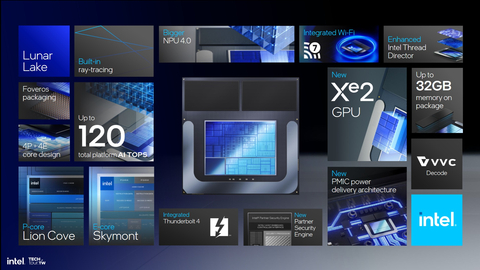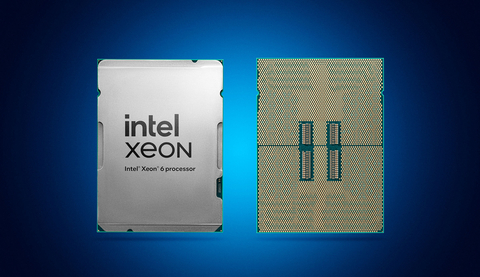인텔이 4일 대만에서 진행된 컴퓨텍스(Computex)에서 데이터센터, 클라우드와 네트워크에서 엣지 및 PC에 이르기까지 AI 생태계를 획기적으로 가속화할 최첨단 기술 및 아키텍처를 공개했다.
.jpg)
▲인텔 컴퓨텍스 2024에서 팻 겔싱어 CEO가 새로운 칩을 공개했다. / (사진 : 인텔)
제온 6 프로세서, AI 에브리웨어 구현
가우디 AI 가속기, 고성능 생성형AI 제공
노트북 PC에서 온디바이스 AI 가속화
인텔이 4일 대만에서 진행된 컴퓨텍스(Computex)에서 데이터센터, 클라우드와 네트워크에서 엣지 및 PC에 이르기까지 AI 생태계를 획기적으로 가속화할 최첨단 기술 및 아키텍처를 공개했다.
주요 내용으로는 △인텔 제온 6 E-코어 프로세서 출시 △인텔 가우디 2 및 인텔 가우디 3 AI 가속기 키트 가격 정책 △ AI PC의 성장을 지속할 루나레이크 클라이언트 프로세서 아키텍처 등이 공개됐다.
팻 겔싱어(Pat Gelsinger) 인텔 CEO는 “AI는 업계 역사상 가장 중대한 혁신의 시대를 주도하고 있다”면서 “반도체는 다시금 기하급수적인 컴퓨팅 성능의 진전을 가져올 것이며 이는 인간의 잠재력의 한계를 뛰어넘고 향후 수년간 전세계 경제를 견인할 것이다”라고 전망했다.
팻 겔싱어 CEO는 “인텔의 최신 제온, 가우디 및 코어 Ultra 플랫폼은 인텔의 하드웨어 및 소프트웨어 생태계의 역량과 결합해 유연하고 안전하며 지속가능하고 비용효율적인 솔루션을 고객에게 제공한다”라고 강조했다.
■ 인텔, AI 에브리웨어 구현

▲루나레이크의 세부 정보 / (이미지 : 인텔)
겔싱어 CEO는 컴퓨텍스 기조연설에서 AI 기회를 가속화할 개방형 표준과 인텔의 강력한 생태계를 강조했다. △에이서 △에이수스 △마이크로소프트 △인벤텍 등 업계 관계자들이 함께 해 지지를 표명했다.
겔싱어 CEO와 업계 리더들은 인텔이 AI 혁신을 이끌고 차세대 기술을 예정보다 앞서 제공하고 있다는 점을 분명히 했다. 인텔은 6개월 만에 5세대 인텔 제온 프로세서를 출시한데 이어 제온 6 첫 제품을 선보였다.
가우디 AI 가속기를 선공개하고 기업 고객에게 비용 효율적인 고성능 생성형 AI 훈련 및 추론 시스템을 제공했다. 또한, 800만대 이상의 디바이스에 인텔 코어 울트라 프로세서를 탑재해 AI PC 시대를 열었고, 올해 말 출시 예정인 클라이언트 아키텍처도 공개했다.
이러한 발전을 통해 인텔은 실행 속도를 가속화하는 동시에 혁신과 생산 속도의 한계를 넘어 AI를 대중화하고 업계를 활성화하고 있다
■ 인텔 제온 6 프로세서 공개

▲인텔 제온 6 프로세서 / (사진 : 인텔)
디지털 혁신이 가속화됨에 따라 기업들은 노후화된 데이터센터 시스템을 교체하여 비용 절감, 지속 가능성 목표 달성, 물리적 공간 및 랙 공간 활용 극대화하고 기업 전반에 걸쳐 새로운 디지털 역량을 창출해야 한다는 압박에 직면해 있다.
제온 6 플랫폼 및 프로세서 제품군은 이러한 과제를 해결할 목적으로 E-코어(Efficient -core) 및 P-코어(Performance-core) 모델이 설계됐다.
AI 및 기타 고성능 컴퓨팅 요구사항부터 확장 가능한 클라우드 네이티브 애플리케이션에 이르기까지 광범위한 워크로드 및 사용 사례를 처리하며, E-코어와 P-코어는 모두 공통의 소프트웨어 스택과 하드웨어 및 소프트웨어 공급업체의 개방형 생태계와 호환 가능한 아키텍처를 기반으로 구축됐다.
제온 6 E-코어는 데이터센터의 고집적도 스케일아웃 워크로드를 위한 성능과 전력 효율성을 제공 및 3:1 랙 통합, 최대 4.2배의 랙 수준 성능 향상 및 최대 2.6배 와트당 성능 향상 지원이 특징이다.
인텔 제온 6 E-코어가 가장 먼저 출시됐으며 현재 사용 가능한 것으로 전해진다. 코드명 그래나이트 래피즈인 제온 6 P-코어는 다음 분기에 출시될 예정이다.
■ 인텔 가우디 AI 가속기로 고성능 생성형AI 제공
오늘날, 생성형 AI의 역량을 활용하는 것은 더 빠르고 저렴해졌다. 주요 인프라인 x86은 거의 모든 데이터센터 환경에서 대규모로 운영되며, 비용 효율적인 상호운용성과 개발자 및 고객으로 구성된 개방형 생태계의 이점을 제공하면서, AI 역량을 통합하는 데 기반 역할을 한다.
인텔 가우디 3 가속기는 생성형 모델 훈련 및 추론 작업에서의 성능을 지원한다. 8,192개 가속기 클러스터를 갖춘 인텔 가우디 3는 동급 규모의 엔비디아 H100 GPU 클러스터에 비해 학습 시간이 최대 40% 빠르며, 64개 가속기 클러스터의 경우 엔비디아 H100의 라마2 700억개(Llama2-70B) 모델에 비해 최대 15% 빠른 학습 처리량을 제공할 것으로 예상된다고 밝혔다.
또한, 인텔 가우디 3는 라마2 700억개(Llama2-70B) 및 미스트랄 70억개(Mistral-7B)와 같은 LLM을 실행할 때 엔비디아 H100 대비 평균 최대 2배 빠른 추론을 제공할 것이라고 전했다.
인텔은 AI 시스템을 제공하기 위해 글로벌 시스템 공급업체와 협력하고 있다. 이번 컴퓨텍스에서 새롭게 합류한 협력사에는 △에이수스 △폭스콘 △기가바이트 △인벤텍 △콴타 △위스트론이 포함되며, △델 △HPE △레노버 △슈퍼마이크로와 같은 주요 시스템 공급업체를 통해 제품 공급을 확대한다.
■ 노트북 PC용 온디바이스 AI 가속화
.jpg)
▲인텔 컴퓨텍스 2024에서 인텔 기반의 다양한 AI 노트북들이 벽면에 전시된 모습 / (사진 : 인텔)
최근 AI PC분야는 컴퓨팅 경험의 모든 측면을 변화시키고 있으며, 인텔은 이 새로운 카테고리를 창출하는 최전선에 있다. 이제 더이상 빠른 처리 속도나 더 세련된 디자인뿐만이 아니라, 고객의 필요를 예측해 선호도에 맞게 실시간으로 적용하며 생산성, 효율성 및 창의성의 완전히 새로운 시대를 예고하는 엣지 디바이스를 만들고 있다.
AI PC가 2027년까지 신규 PC 중 60%를 차지할 것으로 예상됨에 따라, 인텔은 AI PC를 위한 최고의 하드웨어 및 소프트웨어 플랫폼을 발빠르게 구축했다. 100개 이상의 독립 소프트웨어 제작사(ISV)와 협력해, 300개의 기능을 제공하고 코어 울트라 플랫폼 전반에 걸쳐 500개의 AI 모델을 지원하고 있다.
이날 인텔은 AI PC용 차세대 플래그십 프로세서인 루나 레이크(Lunar Lake)의 아키텍처와 관련한 세부 내용을 공개했다. x86 기반으로 그래픽과 AI 처리 성능에서 한층 발전된 성능과 얇고 가벼운 디자인을 위한 전력 효율적인 컴퓨팅 성능에 중점을 뒀으며 이전 세대 대비 최대 40% SoC 전력 절감과 3배 이상의 AI 컴퓨팅을 제공한다고 강조했다.
최대 48TOPS에 이르며 기본 40TOPS의 AI 성능을 제공하는 4세대 인텔 NPU로 이전 버전보다 최대 4배의 AI 컴퓨팅을 제공해 생성형 AI의 개선이 이뤄졌다. 코드명 배틀메이지 기반 새로운 GPU 디자인은 그래픽을 위한 Xe2 GPU 코어와 AI를 위한 XMX(Xe Matrix Extension) 어레이의 두 가지 부분의 새로운 혁신을 결합했다.
Xe2 GPU 코어는 이전 세대 대비 게임 및 그래픽 성능을 1.5배 향상시키고, 새로운 XMX 어레이는 AI 콘텐츠 제작시 탁월한 처리량을 위해 최대 67 TOPS의 성능을 갖춘 두 번째 AI 가속기를 지원한다.
루나 레이크는 20개의 PC 제조사를 통해 80개 이상의 다양한 AI PC 디자인을 공급할 예정이며 인텔은 올해 4,000만개 이상의 코어 울트라 프로세서 출하 목표 달성을 예상하고 있다. 연말 성수기를 겨냥해 2024년 3분기에 시장에 출시할 예정이다.
.jpg)


.jpg)